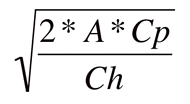Economic Order Quantity (EOQ):
-
Definition of EOQ
-
Formula
-
Example:
Economic order
quantity (EOQ) is that size of the order which
gives maximum economy in purchasing any material and
ultimately contributes towards maintaining the
materials at the optimum level and at the minimum
cost.
In other words, the
economic order quantity (EOQ) is the
amount of inventory to be ordered at one time for
purposes of minimizing annual inventory cost.
The quantity to
order at a given time must be determined by
balancing two factors: (1) the cost of possessing or
carrying materials and (2) the cost of acquiring or
ordering materials. Purchasing larger quantities may
decrease the unit cost of acquisition, but this
saving may not be more than offset by the cost of
carrying materials in stock for a longer period of
time.
The carrying
cost of inventory may include:
- Interest on
investment of working capital
- Property tax
and insurance
- Storage cost,
handling cost
- Deterioration
and shrinkage of stocks
- Obsolescence
of stocks.
The different
formulas have been developed for the calculation of
economic order quantity (EOQ). The following formula
is usually used for the calculation of EOQ.

- A
= Demand for the year
-
Cp = Cost to place a single order
- Ch
= Cost to hold one unit inventory for a
year
- * = ×
|
Pam runs a
mail-order business for gym equipment Annual demand
for the TricoFlexers is 16,000. The annual holding
cost per unit is $2.50 and the cost to place an
order is $50.
Calculate
economic order quantity (EOQ)
Calculation:

Underlying Assumptions of Economic Order
Quantity:
- The ordering
cost is constant.
- The rate of
demand is constant
- The lead time
is fixed
- The purchase
price of the item is constant i.e no discount is
available
- The
replenishment is made instantaneously, the whole
batch is delivered at once.
Relevant Articles:
|